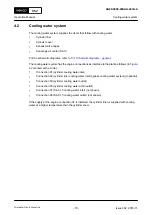
4.8
Scavenge air system
The scavenge air system replaces the exhaust gas in the cylinder with fresh air.
For the schematic diagrams, refer to
13.1 Schematic diagrams - general
The scavenge air comes in from the outside through a duct or from the engine room. The scavenge
air enters at the silencer of the turbocharger.
The scavenge air system has the parts that follow:
•
Scavenge air receiver
The scavenge air receiver (013,
) supplies the cylinders with the applicable
quantity of air.
•
Turbocharger
The compressor (005) of the turbocharger compresses the air to the applicable pressure.
The compressor is attached to the shaft of the turbine (004). The remaining energy of the
exhaust gas operates the turbine and thus the compressor.
•
Auxiliary blower
The auxiliary blower (010) supplies the scavenge air at the engine start and during low load
operation.
•
Auxiliary blower switch box
The auxiliary blower switch box controls the auxiliary blowers.
•
Scavenge air cooler
The scavenge air cooler (SAC) (006) decreases the temperature of the hot compressed air
from the turbocharger. This increases the mass of air and thus increases the quantity of air
that is supplied to the cylinders.
•
Water separator
The water separator (007) removes water from the scavenge air. This prevents damage
and gives better combustion in the cylinders. Water occurs when the scavenge air cooler
decreases the temperature of wet air. Water also occurs during the wash procedure of the
SAC.
•
Drains
The scavenge air system has the drains (009) that follow:
○
Condensation drain from the scavenge air cooler
○
Water drain from the water separator
○
Oily water drain.
X52
AA00-0000-00AAA-043S-A
Operation Manual
Scavenge air system
Winterthur Gas & Diesel Ltd.
- 82 -
Issue 002 2018-11
















































